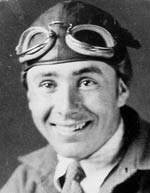|
SCRAPBOOK, 1904-1928
George Witherspoon Faw was born April 7, 1904. He was a young man of 23 years when he visited Tucson Friday, October 7, 1927. He carried a single passenger, H.C. Baber. Based in Los Angeles, CA, they were eastbound to El Paso, TX. They flew the Alexander Eaglerock, registration number 960. No purpose was cited in the Register for their flight, but, because of an old scrapbook (see below), we can piece together his placement at Tucson and what he was doing at the time. The Eaglerock was owned by Dr. Linnie A. Cale of
Los Angeles. Besides H.C. Baber, according to the scrapbook, Cale, or perhaps Cale's son, accompanied Faw as passenger on some of his trips.
George Witherspoon Faw, Date Unknown
(Source: Stokes)
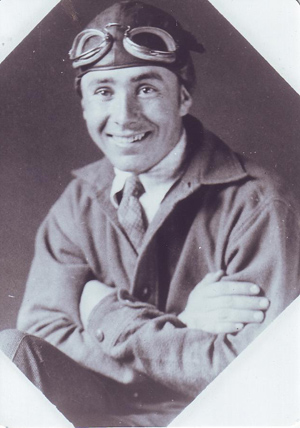 |
Contributor to this Web page, Douglas Stokes (cited in the right sidebar), says of pilot Faw's Register entry, "George Faw's signature is squeezed into the Pilot's column beside the signature of H.C. Baber. I googled Mr. Baber and found him listed as [a City Council member] of [Tempe, AZ] in 1926. George flew many VIP's from the Southwest and he and Earl Cale [not a Register pilot] operated a passenger service out of Clover Field, Santa Monica, CA. George was the pilot and Baber was the passenger. The Eaglerock was the plane used for passenger service...."
George Faw lived a restless youth. Born in North Carolina, his family moved in 1920 to Jefferson, NC in Ashe county in the aftermath of a flood. After high school his family moved to Port Deposit, MD where he enrolled in the Tome Educational and Industrial Institute. I have no record that he completed a course of study there. His family then moved to Salisbury, MD.
Shortly, George departed his family home on an adventure that one newspaper describes as, "...a cross-the-continent hike, biking and footing it all the way except when given a lift by some more fortunate, sympathizing fellow traveler." Another paper clarifies the biking part by identifying the bike as a motorcycle (below, left).
The scrapbook supplied by Mr. Stokes captures in newspaper accounts, in more or less chronological order, his major flight activities between 1925 and 1928. It is clear that he made it to the west coast and settled, and learned to fly there.
George Faw, Ca. 1926
(Source: Stokes)
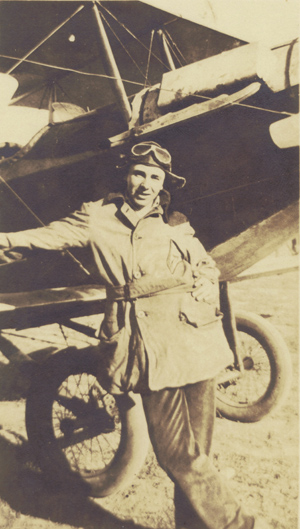 |
More broadly, the articles and quotes attributed to Faw and his collaborators give us an intimate idea of what it was like to barnstorm the American southwest. Through them we listen in on conversations between the pilot superheroes of the day and the locals upon whom they descended on cool mornings and dusty afternoons. For many of the locals, it was their first glimpse of a flying machine.
Soon after learning to fly, according to the Los Angeles Times, August, 1926, Faw competed in the National Air Races (NAR), to the Philadelphia, PA Sesquicentennial, September 4-13. The headline, "Flyer Will Handle New Plane in Race", summarized Faw's assignment to fly, "... a specially designed plane built by L.M. Bach, airplane designer and builder, at Clover Field."
I haven't been able to find any record of Faw entering or completing any phase of the NAR in 1926. One article from September (no day mentioned) places him on the east coast and , "in attendance on the great Sesqui-Centennial air races...." It doesn't mention competition or events. Does anyone KNOW if Faw and the Bach made it to Philadelphia and competed? Regardless, Faw's FAI license, below, would have been in effect during that event.
At left, the compulsory Golden Age photograph of an airplane with its pilot leaning on it casually. Interestingly, this appears to be the same airplane, and Faw appears to be wearing the same coat, as those visible in his NAA license for 1926, just below. Note the boxy shroud around the exhaust system, and the belt around his coat. The airplane appears to be a Curtiss JN model.
George Faw FAI Certificate, June 29,1926
(Source: Stokes)
 |
The general sense of the news accounts, however, is one of hopping from town to town giving rides. While this activity is generally filed under the heading "barnstorming", or "gypsy flying" as he called it (below, left), his major interest seemed to be in establishing an air taxi service and generally exploring possibilities for settling down in the appropriate town and working in aviation.
"Gypsy Flying" Ca. 1926-27
(Source: Stokes)
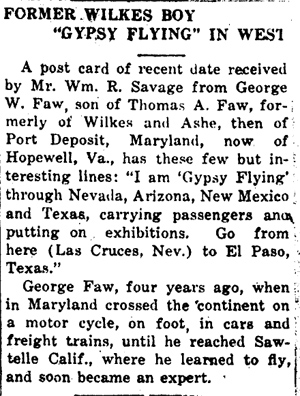 |
The news articles document nicely a period of barnstorming by Faw during 1926-1927 in the southwest. The filler article at left (from an unidentified publication in 1926), provides a unique personal quote about his flying at that time. There is an error in this article. Las Cruces is in New Mexico, not Nevada. See the discussion below for how this part of his itinerary fits with others.
His flying revolved around operating the Alexander Eaglerock owned by Dr. Cale. The NASM registration data card for the airplane (follow the link to the airplane, above) lists the owner as "Dr. Linnie A. Cale". In print, Faw is flying with Earl (some papers spelled it "Earle") Cale, who may be related to the owner. We can assume it is the Eaglerock Faw flew to Tucson. One article mentions that his airplane was red and black (but, see below).
There are a few news articles near the date of his Tucson visit that appeared in the Douglas, AZ Daily Dispatch. One dated Saturday, October 8, 1927 has them (Faw and Baber) landing at Douglas, AZ on that day, "...in a trim, black and gold biplane." Seldom do we get color information about our airplanes, whether accurate or not. Regardless, it is easy to construct their flight plan: first Tucson, then Douglas.
Their expressed purpose for their trip was to explore the possibilities of opening an air transport or taxi service in one or more of the towns they planned to visit on their journey. The article states, "They plan to remain in Douglas until Tuesday [that would have been October 11th] to discuss with local business men and civic leaders the prospects here, after which they propose to fly to El Paso to make a similar survey." They actually flew to Deming, NM next.
George Faw's 1928 Transport Pilot License Cover (Source: Hyatt)
 |
To put their purpose into a social context, it was barely six months since Lindbergh's flight across the Atlantic, and interest in air travel was ramping up as a result. Baber, as spokesman for the pair, was eloquent in his position, "We are looking for a community where we will have some prospect of success in the commercial aviation business. Douglas and El Paso look good to us because there is a good prospect of getting an airmail contract when a line is put through this territory. We want to get in on the ground floor and make our living at passenger carrying,commercial photography, instruction and aerial advertising until the time comes when air mail is sent over this route." At right, courtesy of another nephew, C. Hyatt, is the cover for Faw's Transport Pilot license. His license for 1928 is just below.
Indeed, they stayed in Douglas until the following Tuesday. The Daily Dispatch of October 11th headlined, "SIXTY PERSONS SAW CITY FROM THE AIR SUNDAY". The story goes on, "Faw, who is pilot of the red and black biplane, which was seen almost constantly over Douglas Sunday, said last night that his stay in Douglas was eminently successful from a business viewpoint. Sunday afternoon alone 60 persons, men, women and children, saw Douglas from the air."
If you assume a six-hour afternoon and do the math, that's ten people per hour, or one ride every six minutes. Register pilot John Miller, in his book, in the chapter entitled "My Barnstorming System," describes his methodology for giving rides. In fact, with an assistant helping people in and out of the airplane, Miller as pilot was able to deliver 50 flights in an hour. Given this, Faw could easily have logged 60 in an afternoon.
George Faw's 1928 Transport Pilot License (Source: Hyatt)
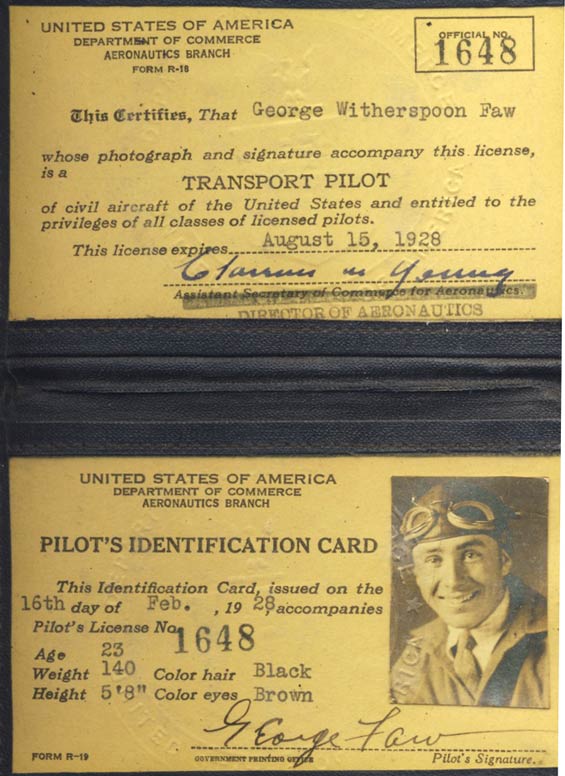 |
But, I digress. Faw and Baber had one criticism of Douglas as a place to establish an aviation business: the airfield was too small. Faw added, "It is large enough for the experienced flyer, but a much larger field would be necessary for instruction purposes. The commercial flyer cannot depend alone on passenger trips for a living. He must have a certain number of flying pupils. ... We intend to keep in touch with the situation in Douglas with a view of returning in a few weeks." With that, they departed for Deming, NM to participate in the Luna County Fair, October 11-15.
Luna County Fair, Concessioner's Pass, October, 1927
(Source: Stokes)
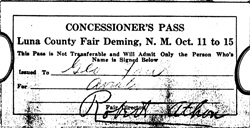 |
At right, a copy of George Faw's concessioner's pass for the fair. The small semicircular shapes at the left and right of this, and other images, are from adhesive labels that held the document in the scrapbook. He flew stunt flights during the day, and moonlight flights at night, which would have been appropriate for a Luna Fair.
The Deming, NM Headlight of October 14th states that the fair was, "... in full blast...." and, "It is worth repeating the fact that at the present time the fair gives every evidence of being self-supporting -- which is saying something." Further, tongue-in-cheek, the Headlight offers an apology upfront, "Mistakes in this issue can be laid to the fact that two-thirds of the working force were up in the air."
The Deming Graphic, October 18, 1927
(Source: Stokes)
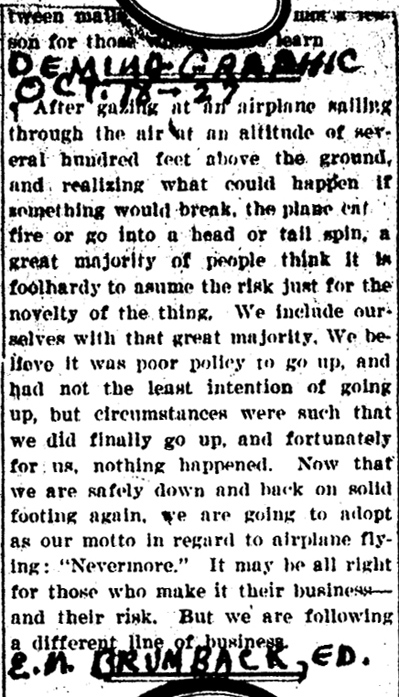 |
In a curious juxtaposition, two editorials, one in the Headlight, October 14 and the other in the Deming Graphic of October 18 present contrasting opinions on contemporary aviation.
The editor of the Headlight is in favor of having an airfield established at Deming and states, "The presence of an airplane here -- or rather, near here -- again brings to our attention the necessity of having a plane landing field. It is too much to expect fliers to land anywhere they can find a cleared place -- they won't do it.
"The experience of Mr. Faw in having to land three miles from town is not a very good advertisement for Deming and something should be done to prevent a repetition of the incident.
"We have plenty of open land on our city borders to make whatever kind of field we need -- and we should get busy now."
The second editorial, in the Graphic, penned by Editor E.M Brumback, is at left.
Rio Grande Farmer, October 20, 1927
(Source: Stokes)
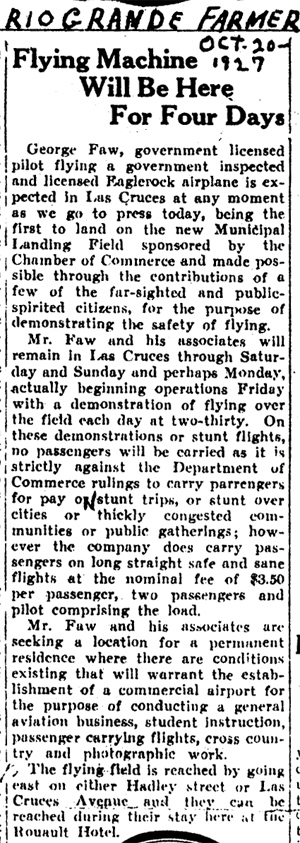 |
After Deming, he headed for what appears from the newspapers to be Las Cruces. The Rio Grande Farmer (Las Cruces, NM, right) of October 20, 1927 headlined, "Flying Machine Will Be Here For Four Days". It was from here that Faw wrote the postcard quoted in the 'Gypsy Flying" article above.
From reading the news articles, it was clear that Faw was meticulous about not "stunting" while he was carrying passengers. Not only was it illegal, it just made good sense. This attitude is explicit in this article.
Below, from the scrapbook, a copy of the handbill circulated to announce Faw's presence in Las Cruces. To see an original handbill, look at this one in the right sidebar at the Cooper Collection.
Las Cruces, NM, Barnstormer's Handbill, October, 1927
(Source: Stokes)
 |
El Paso Post, October 28, 1927
(Source: Stokes)
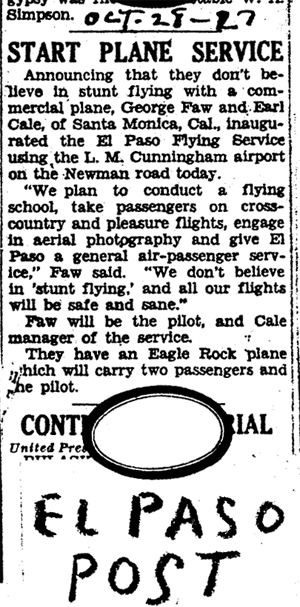 |
As he stated in his postcard, the next stop for Faw was El Paso, TX. There is no press coverage of air meets or demonstrations in El Paso during the latter part of October or the beginning of November. However, according to the article from October 28 at left, he and Cale established a business there named the El Paso Flying Service at the L.M. Cunningham airport. I found nothing regarding that airfield. Does anyone KNOW anything about it?
The El Paso TImes of Monday, October 31, 1927 headlines, "El Paso Has First Taxi In the Air Experience." Indeed, Faw and Cale began service the day before. The article states, "George Faw and Earle Cale just flew into El Paso. A pair of 'gypsy' fliers, they thought they saw in El Paso a future for air development worth the investment of their time, skill, and a new Eaglerock plane owned by them.
"Connections made with L. M. Cunningham who several months ago started clearing a landing field in the faith that there would be planes in El Paso, have assured them a base of operations."
One of their first passengers was quoted in the article, "'Why, it wasn't half so scarey [sic] as turning corners in a real taxi,' confessed a girl passenger, who manfully overcame the manifest temptation to tell a whopper to the friends she had looked down upon from the clouds.
"I--I, of course I was busy looking and maybe forgot to be frightened.
"And who ever said the desert was gray sand? I saw it all, from here to Lordsburg -- it's mauve with green polka dots except where the roads make brown or white stripes across it."
If you have ever flown at low altitude over this part of the country, you know it still looks pretty much the same as it did back in 1927.
Below, from the El Paso Times of Sunday, November 13, 1927, Faw (at left) and his Eaglerock are juxtaposed with a new Packard Six and two adventurous young women, Elizabeth Rogers and Mrs. J.M. Shaughnesy. Faw was working for his newly formed "El Paso Air Service" (sic, see photocaption below).
Plane, Packard, Pilot and Passengers, El Paso Times, November 13, 1927
(Source: Stokes)
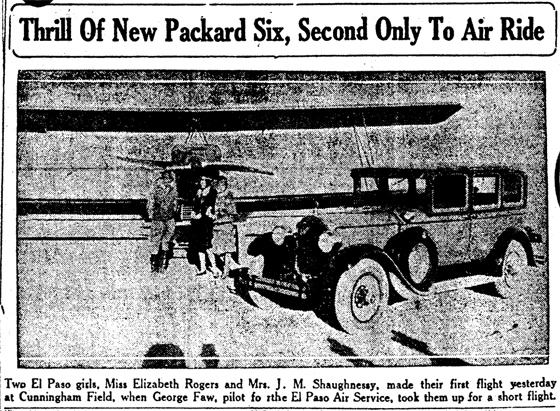 |
As is common in many of these old photographs, the shadows of the photographer and some onlookers in fedoras are visible at the bottom of the shot.
Silver City, NM Enterprise, December 2, 1927
(Source: Stokes)
 |
From his new business in El Paso, Faw returned to Deming, NM in November in time for the Thanksgiving weekend. The Deming Graphic of November 22, 1927 reports, "George Faw, the airplane pilot who was here during the county fair, will arrive here from his headquarters in El Paso Wednesday about noon and will spend Thanksgiving and the weekend in Deming flying passengers.... For those who did not take advantage of this opportunity of flying in an airplane at that time, this will afford an excellent opportunity.... Mr. Faw is connected with the El Paso Flying Service." Perhaps Graphic Editor E.M Brumback had softened by this time.
After Thanksgiving at Deming, Faw shows up at Silver City, NM. The article at right, from the Silver City Enterprise of Friday December 2nd, describes the week he spent there. Although Faw could have said it about any area in the southwest, if you have ever flown over Silver City, it is, indeed, a very beautiful part of the country. The large silver mine there, even though it is an open pit, has its own aesthetic because of the subtle blue coloration of the mine tailings (below). He also dropped in to Lordsburg, NM for a spell. His appearances at Lordsburg, Deming and Silver City were accompanied by site-specific handbills similar to the one shown for Las Cruces, above. Those handbills are preserved in the scrapbook.
Mining Operation Near Silver City, NM, September, 2003
(Source: Webmaster)
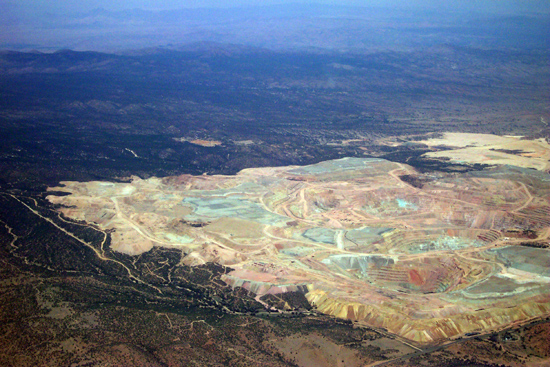 |
A couple of weeks later, he returned to Douglas, AZ in December. This trip was not just for giving rides; it was to transport a VIP greeting committee. The Douglas Daily Dispatch of Saturday, December 17, 1927 headlines, "Air Party Of Los Angeles Coming Today." The party consisted of officials from Maddux Airlines, who were, "... making the flying inspection of the proposed air route from Douglas to Los Angeles ...."
The subject of this article leads to one of the interesting correlations offered by the Davis-Monthan Airfield Register. A party of air transport officials plans to land at Douglas in preparation for establishing air routes in the region. The airline was Maddux, the pilot was Larry Fritz, a frequent visitor at Tucson. His list of passengers, including members of the Maddux board of directors, is clearly presented in the Register. Their airplane was a Ford trimotor, but the registration number is unknown. It was to arrive at Douglas about 4:00PM Saturday.
The mayor of Douglas, A.E. Hinton, as well as Governor George W.P. Hunt, were to fly with Faw in his Eaglerock to rendezvous with the Ford to accompany it to Douglas. It is not clear from the article that this interception occurred. Regardless of whether it did or not, the article states that, "... a dinner dance in honor of the inspection party will be given at the Club Sociale in Agua Prieta this evening beginning at 6:30 o'clock." Agua Prieta, in old Mexico, stands just across the border from Douglas. Prohibition was the law of the land in 1927, but cocktails were legal in Mexico. This was probably the reason for staging the dinner dance there.
According to the article, "The plan is that the party shall spend Saturday night and part of Sunday here [Douglas], taking off for Tucson sometime late Sunday. The inspection program schedules the party to arrive in Tucson on Sunday evening and attend a breakfast given in their honor by the Tucson chamber of commerce on Monday morning."
Indeed, the Maddux Ford is logged in the Tucson Register on Sunday, December 18th at 10:00 PM. Enjoying breakfast on Monday, the Ford and retinue departed the 19th at 2:00PM, headed for Phoenix, AZ. Pilot Fritz noted in the Remarks column of the Register, "Fine field and service."
George Faw's Business Card, Pre-1928
(Source: Stokes)
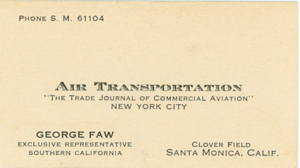 |
At some point during his west coast residence, Faw was "exclusive representative" of an east coast aviation magazine. His family keeps this business card, left, that places him at Clover Field, Santa Monica as a representative for the publisher.
Air Transportation was a United States semi-annual magazine, out of New York, that reported on air freight and air cargo. It called itself the trade journal of commercial aviation (see the advertisment, below, from page 628 of the Aircraft Yearbook for 1930). From December 20, 1930 (starting with volume 15), it adopted the title Aeronautical Industry. The magazine continued publishing until at least 1949.
Air Transportation Advertisement, 1930
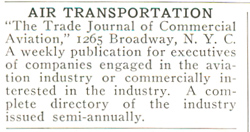 |
A quick Google search reveals that the first twelve volumes of Air Transportation have been published in book form, and older, original volumes show up on eBay occasionally.
George W. Faw, Obituary, April 21, 1928
(Source: Stokes)
 |
George Faw was killed at Fresno, CA (left) in a training accident on April 21, 1928, about six-months after he visited us in Tucson. He was working for yet another company, Beacon Airways. We know from the link to the airplane, above, the craft he was using for instruction in which he died was not his Eaglerock. However, because of other records found at the Smithsonian, we do know that he was flying a Register airplane, Travel Air NC3750.
How sobering that, after we excitedly and expectantly follow his life in the news, we find this tragic end. With the small and brief window into Faw's life provided by the articles in the scrapbook, we followed him for only a few months in the southwest. We can only guess what this young man would have made of himself.
We could venture a guess that, with his enthusiasm, entrepreneurial aptitude, commitment to aviation, and flexibility in accepting employment where and when it became available to support himself, he would have survived the Great Depression with food on his table.
He may have formed his own company, perhaps on his own airport, to serve the training, fuel and maintenance needs of pilots of the Golden Age and beyond. He could have settled in from a life of barnstorming and mobility to one of being a "fixed-base operator" or FBO. FBO's are still common businesses on today's airports; almost every field has at least one.
Or, he may have worked for the government during the yeasty, Golden Age period of airways development and the promulgation of new rules for pilot certification, instrument flight and aircraft safety.
Or, he may have, as did more than a few Register pilots, joined the ranks of one or more of the early air transport companies, enjoyed a low seniority number, and served them, probably with great enthusiasm, through the transition to jet aircraft.
Mr. Stokes says of the scrapbook that presents us these views of pilot Faw, "I spoke to the last remaining sibling of George, a sister now of advanced age, who said that the scapbook was kept by George and was among his belongings when his remains were returned for burial in Blandford Cemetery in Petersburg, VA."
Alas, George Faw's dreams were deferred in the most final way, doing what he chose to do with his life up to that instant. There's a lesson here for all of us.
---o0o---
Dossier 2.1.187
THIS PAGE UPLOADED: 07/18/09 REVISED: 07/23/09, 12/15/10
From time to time, site visitors make observations and send to me their opinions about these pages. I'm particularly grateful for this one received via email 01/21/10:
“The George Faw page is a most evocative preservation of grass-roots flying in that early time, thanks and congratulations.”
As of 03/25/12 this page is Google Rank #1
|



















